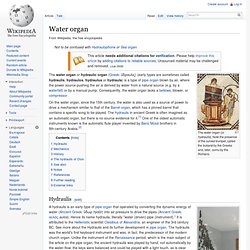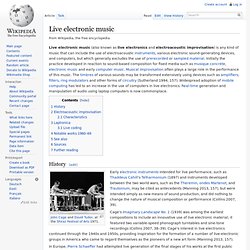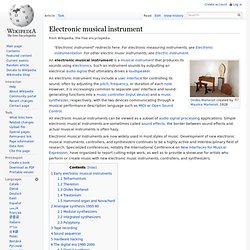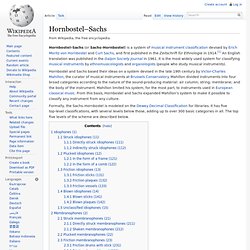

A wearable wireless sensor platform for interactive dance performances. The reacTable. The reacTable. Mtg.upf.edu/system/files/publications/senturk2012Crossole.pdf. .cyclic. SoundGrasp: A gestural interface for the performance of live music - UWE Research Repository. Mitchell, T.

J. (2011) SoundGrasp: A gestural interface for the performance of live music. In: International Conference on New Interfaces for Musical Expression (NIME) 2011, Oslo, Norway, 30 May - 1 June 2011 . Oslo, Norway: UNSPECIFIED Publisher's URL: Abstract This paper documents the first developmental phase of an interface that enables the performance of live music using gestures and body movements. Request a change to this item Total Document Downloads in Past 12 Months. Delivery.acm.org/10.1145/1940000/1935704/p9-rasamimanana.pdf?ip=66.112.227.142&id=1935704&acc=ACTIVE SERVICE&key=603D2E7028CD4EF5%2E4D4702B0C3E38B35%2E4D4702B0C3E38B35%2E4D4702B0C3E38B35&CFID=510451728&CFTOKEN=25139229&__acm__=1405545019_10145611a587f194a. Cmr.soc.plymouth.ac.uk/publications/ACM_Survey_AK_EM.pdf. A Computer Music Instrumentarium. EBL Patron: University of Texas at Austin.
Developing a hybrid wind instrument: using a loudspeaker to couple a theoretical exciter to a real resonator. Between the loudspeaker (with diaphragm section d ) andthe tube (with section t ) has negligible influence on boththe “volume flow rate” and the pressure , so that theycan be considered as equal in both places.

S -domain by usingthe Laplace Transform, with j ω π f and thefrequency in Hz. The RadioDrum. University of Victoria's Music Intelligence and Sound Technology Interdisciplinary Center.

Www.nime.org/proceedings/2001/nime2001_046.pdf. Water organ. The water organ (or hydraulis).

Note the presence of the curved trumpet, called the bukanē by the Greeks and, later, cornu by the Romans. The water organ or hydraulic organ (Greek: ὕδραυλις) (early types are sometimes called hydraulis, hydraulos, hydraulus or hydraula) is a type of pipe organ blown by air, where the power source pushing the air is derived by water from a natural source (e.g. by a waterfall) or by a manual pump. Consequently, the water organ lacks a bellows, blower, or compressor. On the water organ, since the 15th century, the water is also used as a source of power to drive a mechanism similar to that of the Barrel organ, which has a pinned barrel that contains a specific song to be played. The hydraulis in ancient Greek is often imagined as an automatic organ, but there is no source evidence for it.[1] One of the oldest automatic instruments known is the automatic flute player invented by Banū Mūsā brothers in 9th-century Arabia.[2] Hydraulis[edit] Mechanics[edit]
Mogees® : Play the world! Live electronic music. History[edit] Early electronic instruments intended for live performance, such as Thaddeus Cahill's Telharmonium (1897) and instruments developed between the two world wars, such as the Theremin, ondes Martenot, and Trautonium, may be cited as antecedents (Manning 2013, 157), but were intended simply as new means of sound production, and did nothing to change the nature of musical composition or performance (Collins 2007, 39).

Cage’s Imaginary Landscape No. 1 (1939) was among the earliest compositions to include an innovative use of live electronic material; it featured two variable-speed phonograph turntables and sine-tone recordings (Collins 2007, 38–39). Cage's interest in live electronics continued through the 1940s and 1950s, providing inspiration for the formation of a number of live-electronic groups in America who came to regard themselves as the pioneers of a new art form (Manning 2013, 157). Electroacoustic improvisation[edit] Characteristics[edit] Laptronica[edit]
Telharmonium. [Video] Machina's MIDI Jacket Turns Dance Moves Into Sound, And You Can Win One Here. Here at The Creators Project, we've covered a variety of amazing projects that turn dance movements into visuals, but few that transform motion into sound.
![[Video] Machina's MIDI Jacket Turns Dance Moves Into Sound, And You Can Win One Here](http://cdn.pearltrees.com/s/pic/th/machina-creators-project-86445616)
Today, however, we're premiering a documentary on Machina, a Mexico City-based design firm that's created the MIDI Jacket—a wearable device that, as the name implies, translates movement into MIDI music. Check out our documentary about these forward-thinking creators, above, and continue reading to learn about how you can win your very own electronic hoodie, courtesy of Machina and The Creators Project.
Electronic musical instrument. An electronic musical instrument is a musical instrument that produces its sounds using electronics.

Such an instrument sounds by outputting an electrical audio signal that ultimately drives a loudspeaker. All electronic musical instruments can be viewed as a subset of audio signal processing applications. Simple electronic musical instruments are sometimes called sound effects; the border between sound effects and actual musical instruments is often hazy. Electronic musical instruments are now widely used in most styles of music. Hornbostel–Sachs. Hornbostel–Sachs (or Sachs–Hornbostel) is a system of musical instrument classification devised by Erich Moritz von Hornbostel and Curt Sachs, and first published in the Zeitschrift für Ethnologie in 1914.[1] An English translation was published in the Galpin Society Journal in 1961.

It is the most widely used system for classifying musical instruments by ethnomusicologists and organologists (people who study musical instruments). Hornbostel and Sachs based their ideas on a system devised in the late 19th century by Victor-Charles Mahillon, the curator of musical instruments at Brussels Conservatory. Mahillon divided instruments into four broad categories according to the nature of the sound-producing material: air column; string; membrane; and the body of the instrument. Mahillon limited his system, for the most part, to instruments used in European classical music.
Formally, the Sachs–Hornbostel is modeled on the Dewey Decimal Classification for libraries.